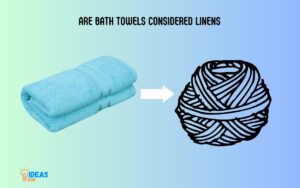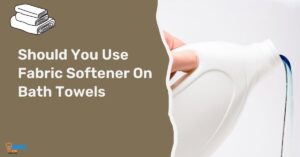How Long Should You Keep Bath Towels? Find Out!
Bath towels should ideally be replaced every one to two years. The lifespan of a bath towel depends on multiple factors such as the quality of the towel, how frequently it’s used, and how well it’s maintained.
However, in general, towels start to lose their absorbency and become less effective after a year or two. Older towels can harbor bacteria, making it important to replace them regularly.
- High-quality towels can last up to two years with regular use.
- Regular washing and drying routine extends the lifespan of your towels.
- Over time, towels lose their absorbency and softness.
- Bacteria can build up in older towels, leading to potential health risks.
Regular maintenance and proper care can extend the lifespan of your bath towels. This includes washing them after every three uses, using a gentle detergent, and avoiding fabric softeners, which can decrease absorbency.
Despite this, remember that even the best care cannot prevent the natural wear and tear, hence the recommendation to replace your towels every one to two years.

Key Takeaway
Knowing When To Replace Your Bath Towels
Bath towels should be replaced every one to two years, depending on their condition. Look for signs of wear such as fraying edges, thinning fabric, or a musty odor, indicating it’s time to invest in new ones.
Bath towels are an essential part of our everyday lives, providing comfort and functionality. However, like any other item, they too have a lifespan.
Knowing when to replace your bath towels can ensure that you continue to enjoy the benefits of a fresh and absorbent towel.
Here are some signs that indicate it’s time to bid farewell to your old towels:
Signs Of Wear And Tear
- Frayed edges: Check the edges of your towel for any fraying or unraveled threads. Over time, constant use and washing can cause the fabric to weaken, leading to visible signs of wear and tear.
- Faded colors: If your once vibrant towel has lost its luster and appears dull or faded, it may be a sign that the fabric is reaching the end of its usable life.
- Holes or tears: Look for any holes or tears in the fabric of your towel. These can occur from sharp objects or excessive use, and can compromise the towel’s ability to absorb moisture effectively.
Changes In Fabric Quality
- Rough texture: As towels age, the fabric can become rough and coarse. If your towel feels scratchy against your skin, it may be an indication that the fibers have worn down and are no longer as soft and comforting as they once were.
- Thinning fabric: Over time, the fabric of a towel can become thin and less plush. If you can see through the towel or it feels thinner than before, it’s a clear sign that the fibers are becoming worn and the towel may not provide the same level of absorbency.
Loss Of Absorbency
- Excessive lint: While lint is normal during the initial use of a new towel, if you notice that your towel continues to shed excessive lint even after multiple washes, it may be a sign of decreased absorbency.
- Wets slowly: Pay attention to how quickly your towel absorbs water. If it takes longer than usual to soak up moisture or leaves your skin feeling damp, it could be an indication that the towel has lost its absorbency.
- Moisture retention: After drying off, a good towel should quickly release moisture when hung up. If your towel remains damp for longer periods, it may be a sign that the fibers have become compacted or damaged, hindering proper drying.
Replacing your bath towels when they exhibit these signs of wear and tear, changes in fabric quality, or loss of absorbency will ensure that you continue to enjoy the benefits of a fresh, soft, and absorbent towel after each use.
So, keep an eye on these indicators and treat yourself to a new set of cozy bath towels when it’s time to say goodbye to the old ones!
Factors To Consider When Replacing Bath Towels
When replacing bath towels, it is important to consider how long you should keep them. Taking into account factors such as wear and tear, hygiene, and overall quality will help determine when it’s time for a towel refresh.
When it comes to bath towels, there comes a time when you need to replace them. But how do you know when it’s time to say goodbye to your old faithful towels?
Several factors should be taken into account when deciding whether or not to replace your bath towels.
Let’s explore these factors to help you make an informed decision:
Frequency Of Use:
- How often do you use your bath towels? Regular use can wear them out faster.
- Do you have multiple towels in rotation, or do you rely on just one or two? More frequent use may require more frequent replacement.
- Are the towels used by multiple family members? Shared usage might lead to quicker deterioration.
Washing And Care Instructions:
- Do you follow the proper washing and care instructions for your towels? Neglecting these guidelines can shorten their lifespan.
- Are the towels regularly exposed to harsh chemicals such as bleach or fabric softeners? These substances can weaken the fibers over time.
- Do you hang the towels to dry or leave them crumpled up while wet? Proper drying techniques can extend their longevity.
Budget And Affordability:
- Are you in a position to invest in new towels? Budget constraints may affect your decision.
- How much are you willing to spend on bath towels? Higher-quality towels tend to last longer.
- Are there any budget-friendly alternatives available? Consider options that offer both durability and affordability.
By carefully considering these factors, you can make an informed decision about when to replace your bath towels.
Whether it’s due to frequency of use, adherence to washing and care instructions, or budget constraints, it’s important to ensure that your towels remain fresh, absorbent, and comfortable for your everyday needs.
Best Practices For Extending The Lifespan Of Your Bath Towels
Extend the lifespan of your bath towels with these best practices. Discover how long you should keep your towels for optimal usage and care.
Proper washing techniques:
- Sort your towels by color to avoid color bleeding during the wash.
- Use a gentle or delicate cycle to prevent excessive wear and tear.
- Choose a mild detergent that won’t leave residue or damage the fabric.
- Avoid using fabric softeners as they can decrease the towel’s absorbency.
- Wash towels separately from clothing items that may snag or pill the fabric.
- Opt for warm water instead of hot water to avoid shrinking the towels.
- Don’t overload the washing machine, allowing the towels to move freely for a thorough clean.
Drying methods:
- Shake out the towels before placing them in the dryer to remove excess water and help prevent wrinkles.
- Use a low or medium heat setting to avoid damaging the fabric fibers.
- Avoid over-drying, as it can make the towels stiff and reduce their absorbency.
- Consider using dryer balls or clean tennis balls to fluff up the towels and improve airflow.
- Hang the towels outside to air dry on a sunny day for a fresh scent and energy-saving alternative.
Storing and airing out towels:
- Make sure towels are completely dry before storing them to prevent mustiness and mildew.
- Choose a well-ventilated area, such as a linen closet or open shelf, to keep towels fresh.
- Fold towels neatly to maximize storage space and avoid unnecessary creasing.
- Rotate your towel usage, allowing each towel to fully dry between uses.
- Consider airing out towels in the sun periodically to naturally eliminate any lingering odors.
- Avoid storing towels in a humid bathroom, as it can promote bacterial growth and reduce the towel’s lifespan.
By following these best practices for washing, drying, and storing your bath towels, you can extend their lifespan and continue enjoying their softness and absorbency for years to come.
How To Revitalize Old Bath Towels?
Wondering how long you should keep your bath towels? Learn how to revitalize old bath towels with these simple tips to extend their lifespan and keep them fresh and absorbent.
Tips For Restoring Absorbency:
- Wash with vinegar: Add 1 cup of white vinegar to the rinse cycle when washing your towels. This helps to remove build-up and restore their absorbency.
- Avoid using fabric softener: Fabric softeners can leave a residue on towels, reducing their absorbency. Instead, use dryer balls or vinegar as a natural alternative.
- Use baking soda: Add half a cup of baking soda to the wash cycle to help break down any lingering odors or residue in the towels.
- Opt for hot water: Washing towels in hot water can help to kill bacteria and remove any trapped dirt or oils, improving their absorbency.
- Skip the dryer sheets: Dryer sheets can leave a waxy coating on towels, reducing their ability to absorb moisture. It’s best to skip them altogether.
Refreshing The Fabric:
- Soak in saltwater: Fill a basin or sink with cold water and add half a cup of salt. Let your towels soak for a few hours, then rinse and wash as usual. This can help to refresh the fabric and remove any lingering odors.
- Use lemon juice: Add half a cup of lemon juice to the rinse cycle to brighten and refresh your towels. Lemon juice can help to remove stains and leave your towels smelling fresh.
- Hang them in the sun: Sunlight has natural disinfectant properties and can help to freshen up your towels. Hang them outside on a sunny day to let the sun work its magic.
Diy Remedies:
- Baking soda and vinegar soak: Create a paste using baking soda and water, and apply it to any stains or areas of discoloration on your towels. Let it sit for a few minutes, then rinse and wash as usual.
- Hydrogen peroxide: Light-colored towels can sometimes develop yellow stains over time. Apply hydrogen peroxide to the stained areas and let it sit for a few minutes before washing. This can help to remove the stains and brighten the fabric.
- Borax treatment: Dissolve half a cup of borax in hot water and soak your towels for a couple of hours. Rinse and wash as usual. Borax can help to remove odors and restore the absorbency of your towels.
By following these tips for restoring absorbency, refreshing the fabric, and trying out some DIY remedies, you can extend the lifespan of your old bath towels and enjoy their softness and absorbency for longer. Give them some TLC, and they’ll be as good as new in no time.
Eco-Friendly Alternatives To Disposing Of Old Bath Towels
Looking for eco-friendly alternatives to dispose of old bath towels? Instead of throwing them away, consider donating them to animal shelters or repurposing them as cleaning rags.
Repurposing Towels:
- Use old bath towels as cleaning rags for household chores like dusting, wiping surfaces, or mopping floors. These towels are absorbent and perfect for tackling various cleaning tasks.
- Transform your old towels into bath mats by cutting them into smaller pieces and sewing the edges to prevent fraying. This not only gives your bathroom a unique touch but also reduces waste.
- Convert old towels into reusable shopping bags by sewing them together and adding handles. These eco-friendly alternatives help reduce plastic usage and are stylish too.
- Cut up old towels to create reusable napkins or handkerchiefs. They are gentle on the skin and can be easily washed after use, promoting sustainability and reducing paper waste.
- Create comfortable pet beds by folding and sewing large towels together. Animal shelters often require bedding for their furry residents, and your old towels can provide the perfect solution.
Donating To Animal Shelters:
- Contact local animal shelters or rescue organizations to see if they accept donations of old bath towels. These establishments often have a need for towels to provide comfort and bedding for animals awaiting adoption.
- Towels can be used to line crates, provide warmth, or clean up messes in animal shelters. Your donation can go a long way in ensuring the well-being of animals in need.
- By donating your old towels, you contribute to the sustainability of these organizations as they can allocate their funds to other important areas of animal care. Plus, you give your discarded towels a second life!
Upcycling Projects:
- Turn your old towels into colorful and absorbent dishcloths. Simply cut them into smaller pieces and finish the edges to create reusable kitchen essentials.
- Convert your old bath towels into bathrobes or beach cover-ups. With some basic sewing skills, you can give your towels a new purpose and enjoy cozy loungewear or stylish beachwear.
- Repurpose old towels as picnic blankets or outdoor cushions. These versatile pieces can be folded and utilized for comfortable seating or as a protective layer for outdoor activities.
- Get creative and use old towels to make tote bags, bath poufs, or even stuffed toys. With upcycling projects, the possibilities are endless, and you can indulge in DIY crafts while reducing waste.
Remember, before disposing of old bath towels, consider these eco-friendly alternatives. Repurposing towels, donating to animal shelters, and engaging in upcycling projects are impactful ways to minimize waste, promote sustainability, and give your towels a renewed purpose. So, grab those old towels and let your imagination run wild with creative possibilities!
Conclusion
Determining how long you should keep your bath towels depends on several factors. The quality of the towels, frequency of use, and proper care and maintenance all play a role in their lifespan.
On average, it is recommended to replace your bath towels every 1-3 years to ensure optimal hygiene and functionality.
Signs such as fading colors, frayed edges, and an unpleasant odor indicate that it’s time for a replacement. Regular washing, gentle drying, and avoiding the use of fabric softeners can help prolong the life of your towels.
By keeping these guidelines in mind, you can maintain a fresh and comfortable bathroom experience while being mindful of your towel’s lifespan.
So, the next time you reach for your towel after a refreshing shower, remember to assess its condition and consider if it’s time for an upgrade.






